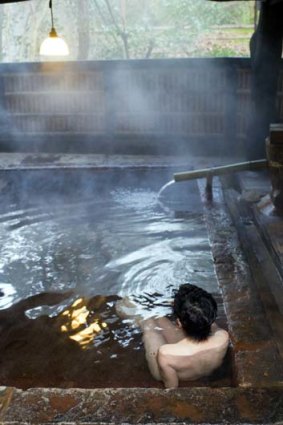
Hot rocks ... immersion therapy in Kurokawa Onsen.Credit: Getty Images
Lee Langley discovers why Kyushu's hot springs are a year-round magnet for hedonists.
The American girl has a backpack and walking boots. As an antidote to Manhattan stress, she's here to go hiking and, weather permitting, climb the slopes of Mount Aso, Japan's largest live volcano. She eyes my sandals and wheelie suitcase.
"Why are you heading for Kurokawa?"
"I'm here for the baths."
I could also have said I was here for the pots. This south-west corner of Japan is known not only for its volcano and its onsen - hot-spring resorts - but also for its traditional ceramics.
One of Japan's four main islands and the most southerly, Kyushu was, until recently, somewhat overlooked as a tourist destination, a Cinderella to the more obvious attractions of the main island of Honshu.
But travellers are beginning to go further afield: enthusiasts come here in search of the Imari and Arita pottery the area is famous for, while the more energetic go hiking, cycling and climbing.
True hedonists visit the villages where rotenburo - open-air, natural hot-spring pools - bubble from the volcanic earth, drawing visitors from all over Japan and, increasingly, from abroad.
Aso Station is the closest the train gets to the area; from here, I join locals on a bus that trundles for about an hour around zigzag bends into the mountains through a thick, white mist to Kurokawa Onsen, a spa village in a steep valley. Sanga Ryokan is set on the hillside, several buildings scattered among the trees. Streams tumble over boulders and find a dozen paths down the hill. Mayu, the charming, kimono-clad daughter of the house, is the sole English speaker.
My "personal attendant", Toki, fussing over my wellbeing, shows me to my room, the sound of water drifting through open windows. Time for my first hot-spring bath. Up a sloping path and down narrow stone steps cut into the rock is a small wooden structure: the "private pool for ladies". I strip, shower and rinse off. Outside the back door is a circular granite tub, like a big paddling pool, with a tiled roof and open sides, overlooking the treetops. Nearby a waterfall drops into a stream. Rain seeps from the grey bowl of the sky.
I had imagined an outdoor bath as a soak in the sun but I see now that bad weather accentuates the charm of the rotenburo; indeed, some addicts prefer winter visits, when the baths are surrounded by snowy slopes. I step in, cautiously; the water is blazing hot. I stretch and doze to the sound of water cascading gently into the pool. Forty minutes later, after a bracing cold shower, I return to my room for dinner.
Sanga specialises in seafood and local produce. I count eight courses, including a dish of pink sashimi - "Basashi," murmurs Toki encouragingly. (Later I learn basashi is raw horse meat.) There's salad wrapped in a bracelet of leek ribbon, a trembling egg custard, a disc of grilled beef. And, of course, warm sake. My eyelids are drooping; it's early but my futon is ready.
The next day is grey and overcast and I choose the women's communal outdoor bath: a big pool surrounded by rocks, absurdly picturesque. In high season (November and during cherry-blossom time in spring), the pool would be full of naked Japanese women.
Today I dream alone as steam rises from the surface. Nearby, the shrubs glisten, rustling in the breeze and drizzle. It all induces a trance-like calm. Later I explore the village. Groups of young women, giggling, approach the tourist office to buy day passes: small discs of polished wood, officially stamped, which admit them to three or more rotenburo.
It's raining steadily as I cross a footbridge above the churning stream, umbrella flapping. Swept by the wind and rain I feel like a figure in a Hiroshige woodblock.
Each ryokan has its own character: one has a bath deep in a cave, another overlooks a stream with ducks. Some are modern, others rustic.
A surprise awaits me. As a reward for my interest in the onsen culture, I have been upgraded to a four-room suite: outside the back door is my own private rotenburo - a tiny, enchanted forest pool.
And the sun is shining. I wander the hillside, hang over a frail footbridge and watch the water below, study the flowers, listen to the birds. In due course my hot-spring bath awaits me.
FAST FACTS
Getting there
Malaysia Airlines has a fare to Tokyo from Sydney and Melbourne for about $1310 low-season return including tax. Fly to Kuala Lumpur (about 8hr), then to Tokyo (6hr 40min); see malaysiaairlines.com. From JR Tokyo Station, take the Shinkansen Nozomi (bullet train) to JR Hakata Station (5hr 40min), change to Shinkansen Sakura to JR Kumamoto Station (40min), then take Kyushu Odan Tokkyu to JR Aso Station (1hr) . At Aso, take a bus or taxi to Kurokawa Onsen.
Staying there
Rooms at Sanga Ryokan cost from 15,900 yen ($190) a person, including breakfast and dinner; see www.sanga-ryokan.com.
When to go
Cherry blossom time in Kumamoto, near Kurokawa Onsen, begins about March 24; see japan-guide.com/e/e2011-when.html.
More information
See jnto.org.au; www.hyperdia.com/en.
- Telegraph, London
Sign up for the Traveller Deals newsletter
Get exclusive travel deals delivered straight to your inbox. Sign up now.